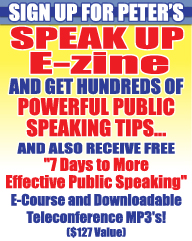Peter Fogel’s “Simple Ground Rules to Help Any Public Speaker ‘Find The Funny’ in Any Speech!”
I always tell my Public Speaking Coaching Clients that it is a hell of a lot easier to be speaker who uses humor in your presentations — than it is to become a comedian who has to be funny for a straight forty-five
to sixty minutes.
Why is that? Because the bar is lower for you. A comic must get a certain amount of laughs per minute (and is constantly judge) a speaker does not. You see, the beauty of public speaking is that all you have to do is add just the right amount of humor to cement your important message into the hearts and minds of your listeners for optimal effect.
As in any craft, it’s important to know the rules to “Creating the Funny” out of thin air. You cannot just blurt out humorous jokes and expect your audience to burst into laughter especially if what you were
discussing moments ago was serious. That would be a disconnect and confuse your listeners.
There are at least two fundamental rules to know when creating humorous speeches. Yes, these
rules can be broken, but the most part every speaker (newbie or veteran) should adhere to them in some form or another.
1) The Truth is Always Funny: Humorous speeches should be based in reality. When the content is obviously trapped in fiction and fantasy, most people won’t buy it. Audiences can sense when something rings untrue.
2) Unexpected Twist – Never telegraph where you are going with your humorous story or speech. The more unexpected surprise you can bring to your humorous speech, the bigger the laughs you will create.
As a general rule, its best that your audience be involved or can relate to your story or situation. Again, as I have stated in other articles, your job as a speaker or humorist when crafting a humorous story is to make sure it cements your message or content. Telling a story out of context will only confuse your audience.
Your best bet in creating a humorous speech is to have your story true (or based on a true event). For instance, if you are weaving a tale that didn’t happen to you but to someone else, then you should paint a
vivid picture in the audiences mind so they can feel totally engaged as to what happened to the other person. In addition, the audience should know what your relationship was with that person (and why it is important to even tell this tale.
For instance; “This is what happened to my father who was my best friend and the single most important influence in my life…!”
See the difference? Audiences can relate to that third person type of story-telling. Hopefully, most audiences smile when they think of their father and the influence they had in their lives. (Not me, of course, but that is whole different story.)
Getting back to the business at hand, your best bet is to humorous stories of every like missing a bus… a plane… standing in long lines… stupid people that infuriate you. Craft that story and tell it to reinforce a
message or content you are delivering.
I live for finding every day craziness and telling my tale to my eager audiences. On the flipside, invented stories are easily detected by your listeners and will not give you a ROIL (return-of-Infectious-laughter), so please try to avoid them.
As you proceed on your journey to delivering humorous speeches, consider studying some simple yet effective steps below:
- Be Expressive – It’s essential that a public speaker be a enthusiastic storyteller. You have to
make sure that every funny situation sounds real. Make the audience feel the emotions of the story until they grasp the content of the situation. - Keep It Simple – Being a professional speaker doesn’t require you to use heavy languages or
vocabularies. In order to make sure that every person in the crowd to understand the humorous speeches, you have to make use of lighter words. This is to make them comprehend what is funny in the situation and why did it become humorous. - Exaggerate your Actions – Tell the story as if you are telling the tale the first time. Be excited and passionate about it, but don’t rush it and get to the punch-line so quickly. Like a fine wine, let it air out and savor the moment. An effective way to slow down and let your audience take in your humorous speech is to exaggerate your gestures. Not only are you making people laugh with your funny remarks, but you’re also able to add more fun using your whole body to show the absurdity of the situation you are telling. This heightens the story. Don’t mug, but let it come naturally.
- Get Your Groove On– When creating humorous speeches, there are certain segments of the story that must be emphasized, while other words must be pronounced slowly. At one point, you get faster, at another point you must pause-and-breathe. Thankfully, changing your rhythm helps keep your audience engaged and makes sure they do not know where you are going with your humorous story or anecdote. Remember: you want to create the unexpected. The moment your audience
knows what is happening next, you will lose the element of surprise… - Record Yourself – Pros do it to improve and so should you. Taping (either video or audio) will
show you how to enhance your presentation. Doing so allow you check your pronunciation, grammar and overall delivery — plus show you how to improve.
Listen to your voice and ask yourself: Are the words clearly spoken? Is the punch-line properly emphasized? Were you able to deliver all the humorous speeches the way they you wanted? Did the audience laugh? Can you improve upon the delivery and punch-line?
Take-Away: The important thing in creating humorous speeches is sharing the experience with your audience in a way that stays with them after the presentation is over. A good story for a speaker is to blend
the humor and pathos together so it makes a more powerful impact. This is why story telling is such an important skill for the professional speaker.
No matter how much you like the story or humorous speech you are delivering, remember this: The final decision as to whether it works will be up to the audience. They are the judge and jury of whether your story hit the mark. Now go forth and be funny! Any quick questions? Then don’t hesitate to contact me at peterfogelspeaks@yahoo.com
###
Before Peter reinvented himself from a successful stand-up comic into an in-demand speaker, freelance advertising copywriter/problem solver, he worked on many TV shows, including Married With Children, Hope and Faith, and Whoopi.
He is the author of the critically acclaimed book If Not Now… Then When?: Stories and Strategies of People Over 40 Who Have Successfully Reinvented Themselves. For info on his book and to sign up for his FREE Reinvent This! E-zine and get his 4-in-1 Total Success Reinvention Package (a $75 value). Go to www.reinventyourselfnow.com/reboot-your-career/
If you’re interested in public speaking, please sign up for Peter’s FREE 7 Days to MORE Effective Public Speaking e-course (a $125 value) and get FREE Mp3 downloads at www.publicspeaklikeapro.com.
















